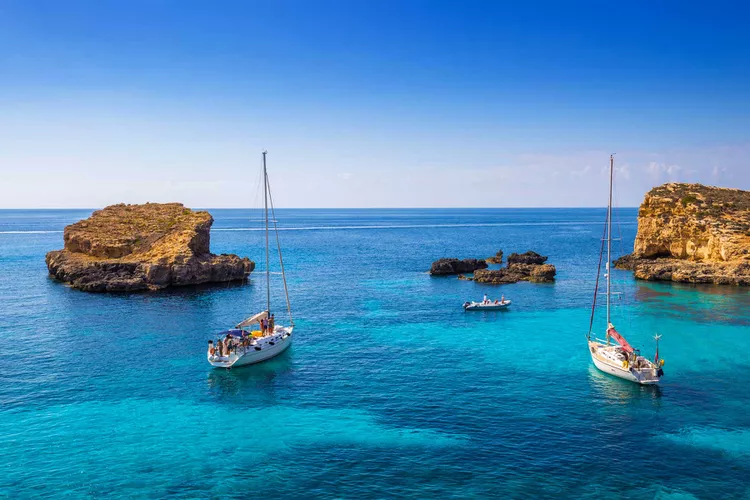Summary of Comino
- Location and Attractions: Comino is a stunning island in the Maltese archipelago, known for its crystal-clear waters, sea caves, and historical significance.
- Historical Background: The island has a rich history, from Roman farmers to a hideout for pirates and exiled knights.
- Activities: Comino is perfect for snorkeling and diving, with numerous underwater caves and marine life to explore.
With stunning blue waters, sea caves, cliffs, and a remote location, Comino is full of swashbuckling adventure.
Fact checked by
In the middle of the Maltese archipelago in the Mediterranean Sea, our boat lazily bobs in the water near a limestone cliff. Fellow passengers take turns jumping into the teal water below, while others float effortlessly around the boat, pointing at a small sea cave in the distance. We’re in a dreamscape called Comino, a small Maltese island home to only two people and the ultimate place to take a dip in the Mediterranean with far less crowds than a typical ocean paradise.
:max_bytes(150000):strip_icc():format(webp)/comino-malta-landscape-PIRATEWTRS0222-0d7d161fb6814bcca9da3dce3c1801f5.jpg)
Comino was inhabited by farmers during Roman rule of the Maltese islands. However, for long stretches of its history, it has either been scantly populated or abandoned completely. The island, home to numerous interconnected sea caves tucked away within the limestone cliffs, has attracted an array of people over the years looking for refuge. In the late 13th century, Comino’s caves were home to the exiled prophetic Kabbalist Abraham Abulafia. It was here in the caves that the recluse wrote “Sefer Ha-Ot” (“The Book of the Sign”) and his last work, “Imrei Shefer” (“Words of Beauty”), before all signs of him were lost.
The Historical Significance of Comino
During the Middle Ages, pirates and corsairs (privateers from the Barbary Coast) utilized Comino and its caves as a base to raid neighboring Malta and Gozo. The deep caves, sheltered by the rugged cliffs, provided the perfect hiding place. They also functioned as trading posts for raids on unsuspecting vessels navigating between Malta and Gozo. In the 16th and 17th centuries, Comino served as a place of exile or imprisonment for errant Maltese knights, several of whom were condemned to the isolated task of manning St. Mary’s Tower, the island’s most notable structure erected in 1618 as part of a defensive network along the Maltese coast.
Today, while only two people live on Comino, the island and its cerulean waters attract visitors who arrive by boat to experience this pristine locale. It was here that films such as “Troy” and “The Count of Monte Cristo” were shot, and popular attractions include the renowned Blue Lagoon, a shallow body of water surrounded by rocks and a white-sand beach, as well as the Crystal Lagoon, a lesser-known gem accessible only by boat, nestled near sea caves. Comino is also an exceptional location for snorkeling and diving, boasting at least ten caves to explore, including the Santa Maria caves and the P31 patrol boat wreck. Each cave offers a unique experience, with underwater tunnels teeming with moray eels, spiny lobsters, octopuses, crabs, damselfish, nudibranchs, mullets, and banded sea bream.
To explore these storied waters, Viking Cruises provides voyages stopping in Malta, allowing excursions that enable guests to sail through and swim at various spots around Comino. Alternatively, you can charter a private yacht or motorboat with JustCruizing, which takes visitors out to swim around Comino and experience its beauty firsthand.




